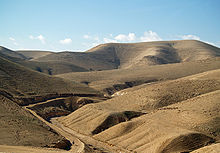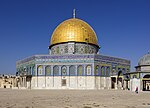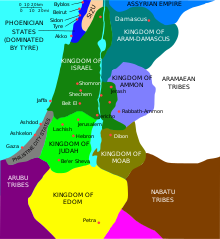| Revision as of 07:57, 26 January 2013 view sourceEmmette Hernandez Coleman (talk | contribs)Extended confirmed users15,272 edits →Roman conquest: See my last edit summery← Previous edit | Revision as of 01:25, 28 January 2013 view source Emmette Hernandez Coleman (talk | contribs)Extended confirmed users15,272 edits →History: Rv, No conciseness to narrow templates scope to just Arab historyNext edit → | ||
| Line 19: | Line 19: | ||
| ==History== | ==History== | ||
| {{History of the Palestinian territories}} | |||
| ===Early Iron Age=== | ===Early Iron Age=== | ||
| {{main|History of ancient Israel and Judah|Kingdom of Judah}} | {{main|History of ancient Israel and Judah|Kingdom of Judah}} | ||
Revision as of 01:25, 28 January 2013
31°41′56″N 35°18′23″E / 31.69889°N 35.30639°E / 31.69889; 35.30639
See also: Judea (Roman province)
Judea or Judæa (/dʒuːˈdiː.ə/; from Template:Lang-he, Standard Yəhuda Tiberian Yəhûḏāh, Template:Lang-el, Ioudaía; Template:Lang-la) is the name of the mountainous southern part of the Land of Israel, roughly corresponding to the southern West Bank. The region is named after the biblical tribe of Judah and associated Kingdom of Judah, which is commonly dated from 934 until 586 BCE. The name of the region continued to be incorporated through the Babylonian conquest, Persian, Hellenistic, and Roman periods as Babylonian Judea, Persian Judea, Hasmonean Judea, and consequently Herodian Judea and Roman Judea, respectively. As a consequence of the Bar Kokhba revolt, in 135 CE the region was renamed and merged with Roman Syria to form Syria Palaestina by the victorious Roman Emperor Hadrian. The term Judea as a geographical term was officially revived in the 20th century as part of the Israeli district name for most of the West Bank - the Judea and Samaria Area.
Etymology
The name Judea is a Greek and Roman adaptation of the name "Judah", which originally encompassed the territory of the Israelite tribe of that name and later of the ancient Kingdom of Judah. Judea was sometimes used as the name for the entire region, including parts beyond the river Jordan. It was the name in use in English until the Jordanian occupation of the area in 1948. Jordan called the area of Judea and Samaria ad-difa’a al-gharbiya (translated into English as the "West Bank"). "Yehuda" is the Hebrew term used for the area in modern Israel since the region was captured and occupied by Israel in 1967.
Historical boundaries

The classical Roman-Jewish historian Josephus wrote:
In the limits of Samaria and Judea lies the village Anuath, which is also named Borceos. This is the northern boundary of Judea. The southern parts of Judea, if they be measured lengthways, are bounded by a village adjoining to the confines of Arabia; the Jews that dwell there call it Jordan. However, its breadth is extended from the river Jordan to Joppa. The city Jerusalem is situated in the very middle; on which account some have, with sagacity enough, called that city the Navel of the country. Nor indeed is Judea destitute of such delights as come from the sea, since its maritime places extend as far as Ptolemais: it was parted into eleven portions, of which the royal city Jerusalem was the supreme, and presided over all the neighboring country, as the head does over the body. As to the other cities that were inferior to it, they presided over their several toparchies; Gophna was the second of those cities, and next to that Acrabatta, after them Thamna, and Lydda, and Emmaus, and Pella, and Idumea, and Engaddi, and Herodium, and Jericho; and after them came Jamnia and Joppa, as presiding over the neighboring people; and besides these there was the region of Gamala, and Gaulonitis, and Batanea, and Trachonitis, which are also parts of the kingdom of Agrippa. This country begins at Mount Libanus, and the fountains of Jordan, and reaches breadthways to the lake of Tiberias; and in length is extended from a village called Arpha, as far as Julias. Its inhabitants are a mixture of Jews and Syrians. And thus have I, with all possible brevity, described the country of Judea, and those that lie round about it.
Geography

Judea is a mountainous region, part of which is considered a desert. It varies greatly in height, rising to an altitude of 1,020 m (3,346 ft) in the south at Mount Hebron, 30 km (19 mi) southwest of Jerusalem, and descending to as much as 400 m (1,312 ft) below sea level in the east of the region. It also varies in rainfall, starting with about 400–500 millimetres (16–20 in) in the western hills, rising to 600 millimetres (24 in) around western Jerusalem (in central Judea), falling back to 400 millimetres (16 in) in eastern Jerusalem and dropping to around 100mm in the eastern parts, due to a rainshadow effect (this is the Judean desert). The climate, accordingly, moves between Mediterranean in the west and desert climate in the east, with a strip of steppe climate in the middle. Major urban areas in the region include Jerusalem, Bethlehem, Gush Etzion, Jericho and Hebron.
Geographers divide Judea into several regions: the Hebron hills, the Jerusalem saddle, the Bethel hills and the Judean desert east of Jerusalem, which descends in a series of steps to the Dead Sea. The hills are distinct for their anticline structure. In ancient times the hills were forested, and the Bible records agriculture and sheep farming being practiced in the area. Animals are still grazed today, with shepherds moving them between the low ground to the hilltops as summer approaches, while the slopes are still layered with centuries-old stone terracing. The Jewish Revolt against the Romans ended in the devastation of vast areas of the Judaean countryside.
History
| Part of a series on the |
|---|
| History of Palestine |
 |
| Prehistory |
| Ancient history |
| Classical period |
| Islamic rule |
| Modern era |
|
|
Early Iron Age
Main articles: History of ancient Israel and Judah and Kingdom of Judah
By the Early Iron Age, around 1020 BCE, the Southern Levant came to be ruled by the Kingdom of Israel, and its successors, the Northern Kingdom and the Kingdom of Judah. The Northern Kingdom was conquered into the Neo-Assyrian Empire in 720 BCE. The Kingdom of Judah remained nominally independent, but paid tribute to the Assyrian Empire from 715 and throughout the first half of the 7th century BCE, regaining its independence as the Assyrian Empire declined after 640 BCE, but after 609 again fell under the sway of imperial rule, this time paying tribute at first to the Egyptians and after 601 BCE to the Neo-Babylonian Empire, until 586 BCE, when it was finally conquered by Babylonia.
Judea is central to much of the narrative of the Torah, with the Patriarchs Abraham, Isaac and Jacob said to have been buried at Hebron in the Tomb of the Patriarchs.
Persian and Hellenistic periods
Main article: Persian JudahThe Babylonian Empire fell to the conquests of Cyrus the Great in 539 BCE. Judea remained under Persian rule until the conquest of Alexander the Great in 332 BCE, eventually falling under the rule of the Hellenistic Seleucid Empire until the revolt of Judas Maccabeus resulted in the Hasmonean dynasty of Kings who ruled in Judea for over a century.
Roman conquest
See also: Iudaea (Roman province)Judea lost its independence to the Romans in the 1st century BCE, by becoming first a tributary kingdom, then a province, of the Roman Empire. The Romans had allied themselves to the Maccabees and interfered again in 63 BCE, at the end of the Third Mithridatic War, when the proconsul Pompeius Magnus ("Pompey the Great") stayed behind to make the area secure for Rome. Queen Alexandra Salome had recently died, and a civil war broke out between her sons, Hyrcanus II and Aristobulus II. Pompeius restored Hyrcanus but political rule passed to the Herodian family who ruled as client kings. In 6 CE, Judea came under direct Roman rule as the southern part of the province of Iudaea. Eventually, the Jews rose against Roman rule in 66 CE in a revolt that was unsuccessful. Jerusalem was destroyed in 70 CE and much of the population was killed or enslaved.
Bar Kokhba revolt
Main article: Bar Kokhba revoltThe Jews rebelled again 70 years later under the leadership of Simon bar Kokhba and established the last Kingdom of Israel, which lasted three years, before the Romans managed to conquer the province for good, at a high cost in terms of manpower and expense.
After the defeat of Bar Kokhba (132–135 CE) the Roman Emperor Hadrian was determined to wipe out the identity of Israel-Judah-Judea, and renamed it Philistina (Syria Palaestina, after the ancient enemy of the Israelites; the Philistines). Until that time the area had been called "province of Judea" (Roman Judea) by the Romans. At the same time, he changed the name of the city of Jerusalem to Aelia Capitolina. The Romans killed many Jews and sold many more into slavery; many Jews departed into the Jewish diaspora, but there was never a complete Jewish abandonment of the area, and Jews have been an important (and sometimes persecuted) minority in Judea since that time.
Jewish resettlement
| This section does not cite any sources. Please help improve this section by adding citations to reliable sources. Unsourced material may be challenged and removed. (August 2012) (Learn how and when to remove this message) |

The Roman conquest greatly diminished Jewish presence in Judea. Since then, the Jewish population of Judea has fluctuated greatly. Beginning in the late 19th century, Jewish settlement increased within the territory of what is now Israel, the West Bank and Gaza, with Judea (or the southern West Bank) attracting a growing number of settlements and resulting in growing conflict between Muslim and Jewish residents of the region. Today, much of the southern West Bank falls under the jurisdiction of the Palestinian Authority, and the presence of Jewish settlers in now-Palestinian cities such as Hebron and the establishment of Jewish settlements (under Israeli jurisdiction) is considered controversial. Jewish settlers have proposed establishing the State of Judea should Israel withdraw from the West Bank.
Timeline
- 11th century BCE–930 BCE — part of the Kingdom of Israel
- 930 BCE–586 BCE — Kingdom of Judah
- 586 BCE–539 BCE — Babylonian Empire
- 539 BCE–332 BCE — Persian Empire
- 332 BCE–305 BCE — Macedonian Empire of Alexander the Great
- 305 BCE–198 BCE — Ptolemaics
- 198 BCE–141 BCE — Seleucids
- 141 BCE–37 BCE — The Hasmonean state in Israel established by the Maccabees, after 63 BCE under Roman supremacy
- 37 BCE–70 CE — Herodian Dynasty ruling Judea under Roman supremacy (37 BCE–6 CE, 41–44 CE), interchanging with direct Roman rule (6–41, 44–66). This ended in the first Jewish Revolt of 66–73, which saw the Temple destroyed in 70.
- 33— execution of Jesus of Nazareth by crucifixion in Jerusalem
- 73 — Fall of Masada
- 115–117 — Kitos War
- 132–135 — Bar Kokhba's revolt
- 135 — Emperor Hadrian reverts to the name Syria Palaestina first used by Herodotus.
See also
References
- LDS.org: "Book of Mormon Pronunciation Guide" (retrieved 2012-02-25), IPA-ified from «jū-dē´a»
- A History of the Israeli-Palestinian Conflict - Mark A. Tessler - Google Books. Books.google.com. Retrieved 2012-12-31.
- http://www.nytimes.com/2008/12/05/world/middleeast/05mideast.html?_r=0
- Jewish Encyclopedia: Judah, Kingdom of
- Studies in Palestinian Geography, Prof. S.J. Riggs, Auburn Theological Seminary, 1894, JSTOR The Biblical World
- "This Side of the River Jordan; On Language," Philologos, September 22, 2010, Forward.
- "Judaea". Britannica. Retrieved 2012-12-31.
- "Ancient History Sourcebook: Josephus (37 – after 93 CE): Galilee, Samaria, and Judea in the First Century CE". Fordham.edu. Retrieved 2012-12-31.
- "Picturesque Palestine I: Jerusalem, Judah, Ephraim". Lifeintheholyland.com. Retrieved 2012-12-31.
- "Unlikely A Tale of Two Conquests: The Unlikely Numismatic Association Between the Fall of New France (AD 1760) and the Fall of Judaea (AD 70)". Ansmagazine.com. Retrieved 2012-12-31.
- "The Persians". Jewish Virtual Library. Retrieved 2009-06-09.
- "The Hasmonean Dynasty". Jewish Virtual Library. Retrieved 2009-06-09.
- "Roman Rule". Jewish Virtual Library. Retrieved 2009-06-09.
- "The Name "Palestine"". Jewish Virtual Library. Retrieved 2010-08-16.
- "Shimon Bar-Kokhba". Jewish Virtual Library. Retrieved 2009-06-09.
External links
- Judea and civil war
- The subjugation of Judea
- Judaea 6–66 CE
- Judea photos
- The Jewish History Resource Center Project of the Dinur Center for Research in Jewish History, Hebrew University of Jerusalem
| Judea and Samaria Area | ||
|---|---|---|
| Cities | ||
| Regional committee | ||
| Regional councils | ||
| Local councils | ||
| See also | ||
- Ill-formatted IPAc-en transclusions
- Judea
- Ancient Israel and Judah
- Ancient Jewish Greek history
- Archaeological sites in Israel
- Biblical places
- Deserts of Israel
- Geography of Palestine
- Geography of the West Bank
- Hebrew Bible places
- Historic Jewish communities
- Historical regions
- Jews and Judaism in the Roman Empire
- Judea and Samaria Area
- New Testament places
- Place names associated with Jews
- Regions of Israel
- West Bank